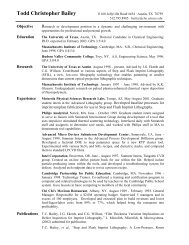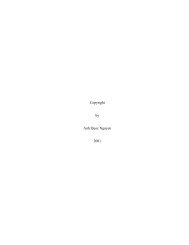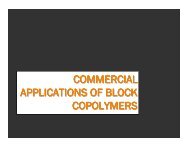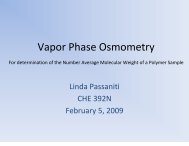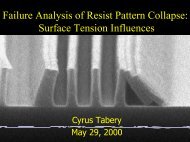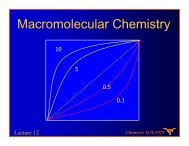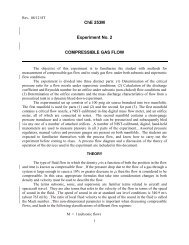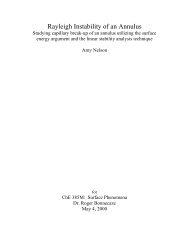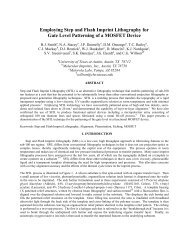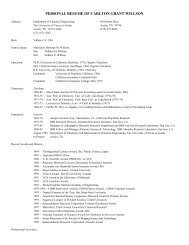Rubber Presentation - Willson Research Group
Rubber Presentation - Willson Research Group
Rubber Presentation - Willson Research Group
Create successful ePaper yourself
Turn your PDF publications into a flip-book with our unique Google optimized e-Paper software.
<strong>Rubber</strong>: History,<br />
Properties and Structure<br />
Katrina Czenkusch<br />
Physical Chemistry of Macromolecules<br />
April 9, 2009
Definition of <strong>Rubber</strong>/Elastomer<br />
“A A material that can be stretched to at<br />
least twice its original length and will<br />
retract rapidly and forcibly to substantially<br />
its original dimensions upon release of the<br />
force.”<br />
Rosen; p389
Natural <strong>Rubber</strong>: Where?<br />
Hevea brasiliensis<br />
– Most common source<br />
– Responds to wounding by producing<br />
more latex<br />
– Produces cis-1,4<br />
1,4-polyisoprene<br />
– Native to Amazon Rainforest<br />
Gutta-Percha<br />
– Produces trans-1,4<br />
1,4-polyisoprene<br />
– Native to Malaysia<br />
<strong>Rubber</strong> Plantations in Malaysia<br />
Pictures: http://en.wikipedia.org/wiki/Natural_rubber
<strong>Rubber</strong> in Prehistory<br />
60 million BC – Europe -<br />
rubber-producing plants<br />
First millennium BC – Mexico –<br />
First evidence of the<br />
Mesoamerican ballgame<br />
6 th century – Mexico and Central<br />
America – Aztecs/Mayans<br />
– Balls<br />
– Dipped Feet to make shoes<br />
– Coated Fabrics<br />
Pictures: http://en.wikipedia.org/wiki/Mesoamerican_ballgame
<strong>Rubber</strong> and Europe<br />
First European exposure<br />
– Columbus supposedly watched a<br />
Mesoamerican ballgame<br />
– Early explorers learned native<br />
waterproofing techniques<br />
Charles Marie de la Condamine<br />
and Francois Fresneau<br />
– Popularized rubber in France<br />
starting mid 1730’s<br />
– Discovered first solvents<br />
– Wrote about properties<br />
Picture: http://en.wikipedia.org/wiki/Charles_Marie_de_La_Condamine
Vulcanization<br />
1839<br />
– Goodyear and Hancock<br />
– Mixed natural rubber, sulfur and white lead on a hot<br />
stove<br />
– <strong>Rubber</strong> was ‘cured’ of all its defects<br />
[ ] n<br />
R'<br />
R<br />
[<br />
CH 3<br />
[<br />
R 2<br />
H 3 C<br />
R + S 8<br />
S<br />
H 3 C<br />
S S<br />
1846<br />
]<br />
– Alexander Parkes invented a cold-cure cure process using<br />
sulfur chloride gas in solution<br />
R 1<br />
2-8 Sulfurs<br />
]<br />
R 3
Natural <strong>Rubber</strong> the Real Story<br />
1860 - Williams (UK)<br />
– Decomposed natural<br />
rubber to isoprene<br />
Isoprene<br />
CH 3<br />
1879 - Bouchardat<br />
(France)<br />
– Repolymerized isoprene to<br />
make rubber<br />
H 2 C<br />
CH 2<br />
cis-Polyisoprene<br />
R [<br />
] n<br />
R'<br />
1910 – Pickles<br />
– <strong>Rubber</strong> is made of long<br />
chains of isoprene<br />
C H 3
Origins of <strong>Rubber</strong> Elasticity<br />
Energy elasticity – elongation resulting<br />
from rotation around single bonds and the<br />
straining of bond angles and lengths
Statistics of Ideal <strong>Rubber</strong> Elasticity<br />
Ideal rubber<br />
Slope of the stress-strain strain curve or Young’s s Modulus<br />
E= ρRT<br />
Mc (2α+ α-2 )<br />
– ρ = density<br />
– R = Gas Constant<br />
– T = temperature<br />
– Mc = number average molecular weight of the network<br />
chains<br />
– α = extension ratio, l/l 0<br />
– l/l 0 = current length/unstretched length
Deviations from Ideality<br />
Under predicts modulus for α > 1.5<br />
Chain ends<br />
Stress induced crystallization
Butadiene <strong>Rubber</strong><br />
Polybutadiene<br />
– First synthesized in 1910 by S. Lebedev<br />
– Very durable but cis/trans issues<br />
– Side walls of truck tires and golf balls<br />
– Modern day use is as copolymer<br />
H 2 C<br />
CH 2<br />
R<br />
cis-1,4-PBD<br />
1,2-PBD<br />
R 2<br />
trans-1,4-PBD<br />
H 2 C
And its copolymers<br />
R<br />
[ ]<br />
R<br />
N<br />
[ R<br />
R ]<br />
Buna N/ Buna NN<br />
– Butadiene and<br />
acrylonitrile<br />
– Increased acrylonitrile<br />
increases stiffness and<br />
oil resistance<br />
Buna S<br />
– Butadiene and styrene<br />
– Increased styrene<br />
leads to stiffer rubber
The War Years<br />
Japan captured Pacific <strong>Rubber</strong> plantations<br />
US synthetic rubber<br />
– 1939 – 2000 tons/yr<br />
– 1945 – 830,000 tons/yr<br />
– Butyl rubber<br />
German synthetic rubber<br />
– Before – 22,000 tons/yr<br />
– Middle – 100,000 tons/yr
Butyl <strong>Rubber</strong><br />
Copolymer of 98% isobutene<br />
– 2% isoprene or butadiene<br />
– Cationic polymerization<br />
– Air impermeable<br />
– Inner tubes for tires<br />
CH 3<br />
H 2 C<br />
CH 3<br />
R +<br />
R<br />
H 3 C<br />
H 3<br />
C<br />
n<br />
R 1
Thermoplastic Elastomers<br />
<strong>Rubber</strong>s which can<br />
be melt processed<br />
after “crosslinking”<br />
Immiscible block<br />
copolymers<br />
– Form matrix of<br />
rubbery polymer with<br />
spheres of hard<br />
segments<br />
– Most common:<br />
Styrene-Butadiene<br />
Butadiene-<br />
Styrene (SBS)<br />
Pictures: http://en.wikipedia.org/wiki/Copolymer
Requirements to make a <strong>Rubber</strong><br />
High Molecular Weight<br />
– <strong>Rubber</strong> elasticity is due to the coiling/uncoiling of chains<br />
Use temperature must be above Tg<br />
– To allow for molecular motion<br />
Amorphous in its unstretched state<br />
– Crystals would hinder coiling/uncoiling<br />
Chains tied together to prevent flow<br />
– Traditionally through crosslinking<br />
– Hard/Soft Domains<br />
– Entanglements<br />
All polymers above Tg act as rubbers due to entanglements<br />
However, when the entanglements break, the polymer will begin to<br />
flow
<strong>Rubber</strong>: History,<br />
Properties and Structure<br />
Katrina Czenkusch<br />
Physical Chemistry of Macromolecules<br />
April 9, 2009
References<br />
<br />
<br />
<br />
<br />
<br />
<br />
<br />
Goritz, , D., Muller, F. H., Sietz, , W.; “Temperature-induced and<br />
Stress-induced Crystallization in Oriented Polymers”, Progress in<br />
Colloid and Polymer Science; ; Springer Berlin/Heidelberg, 1977<br />
Herbert, Vernon; Attilio Bisio; Synthetic <strong>Rubber</strong>, , Greenwood Press,<br />
1985<br />
Hiemenz, , Paul C.; Lodge, Timothy P.; Polymer Chemistry 2 nd ed.,<br />
CRC Press; 2007<br />
James, Hubert M., Guth, , Eugene; Theory of the Elastic Properties of<br />
<strong>Rubber</strong>; ; J. Chem. Phys. 11, 455 (1943)<br />
Loadman, , John; Tears of the Tree, , Oxford University Press, 2005<br />
Rosen, Stephen L.; Fundamental Principles of Polymeric Materials<br />
2 nd ed., , Wiley-Interscience Publication, 1993<br />
Solo, Robert; <strong>Research</strong> and Development in the Synthetic <strong>Rubber</strong><br />
Industry; ; The Quarterly Journal of Economics; Vol 68, No.1 (1954)
From Curiosity to Product<br />
T. Hancock<br />
(1820-1840)<br />
1840)<br />
– Pickling Machine – produce<br />
homogeneous rubber ‘dough’<br />
– Spreader – the standard<br />
coating machine used today<br />
M. Faraday<br />
– Established empirical formula<br />
of natural rubber (C 5 H 8 )
Natural <strong>Rubber</strong> Production<br />
Wild Production<br />
– Amazon River and its tributaries<br />
– Africa<br />
1876 - H. Wickham<br />
– Sent 70,000 Hevea seeds to Britain<br />
– 2397 germinated<br />
– Plants sent to Singapore, India, Malaysia<br />
– Foundation of the eastern rubber plantations (1895)<br />
1913-1914<br />
1914 - Plantation rubber exceeds wild



